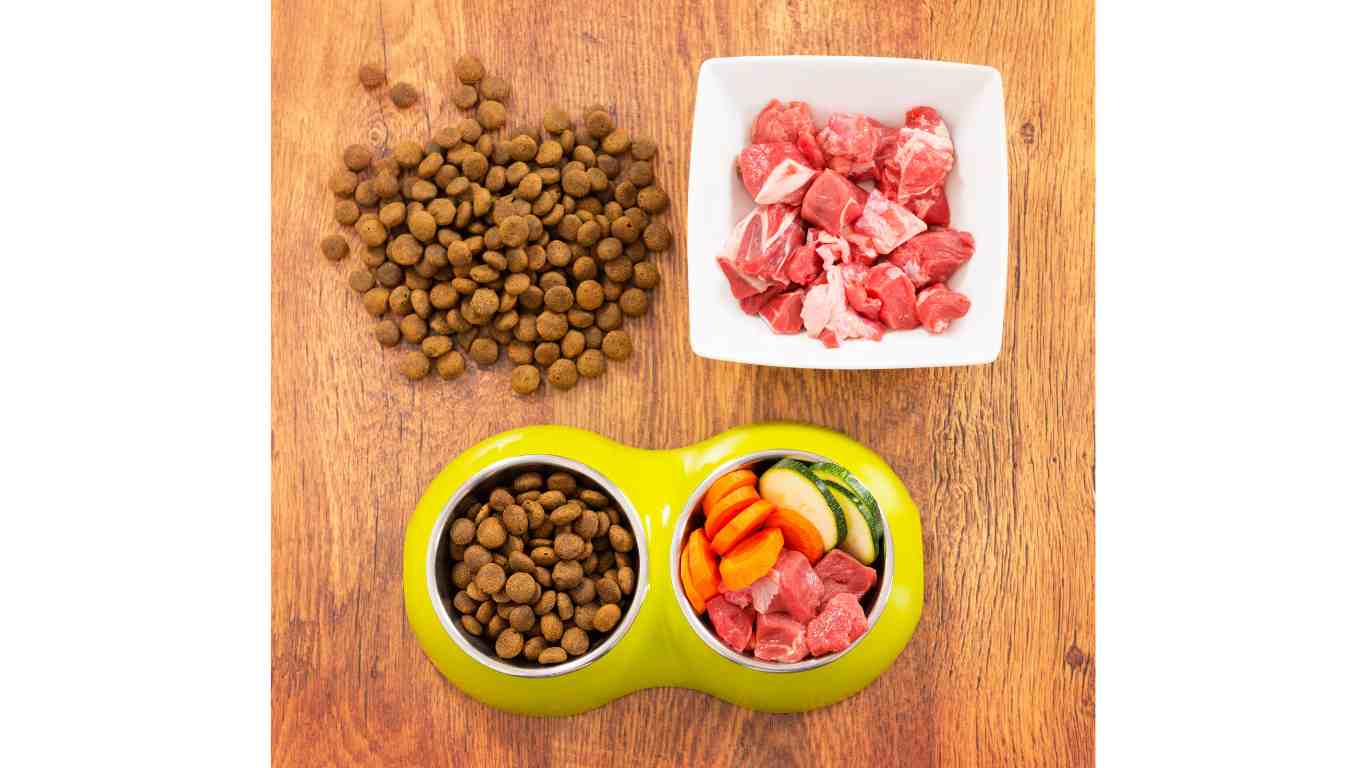If your dog is constantly scratching, experiencing hair loss, or suffering from itchy skin, they may have skin allergies. Switching to homemade dog food can address their dietary needs and alleviate these discomforting symptoms. In this article, we will explore the causes and symptoms of skin allergies in dogs and provide a nutritional guide to homemade dog food for skin allergies with a list of the top 10 recipes. We will also offer tips for successfully transitioning your dog to a homemade diet to minimize issues like hot spots, ear infections, and flea allergy dermatitis.
What Causes Skin Allergies in Dogs and How to Identify Them
Skin allergies in dogs can be caused by various factors, including food allergies, flea saliva, dust mites, and more. It is important to identify the underlying cause of your dog’s skin allergies to effectively manage their condition and alleviate discomfort. By recognizing the symptoms and conducting thorough evaluations, you can determine the specific allergens affecting your dog.
Common Symptoms of Skin Allergies in Dogs:
- Incessant itching: Dogs with skin allergies often scratch themselves excessively, leading to redness, irritation, and potential hair loss.
- Hair loss: Allergic reactions can cause dogs to experience hair loss in affected areas.
- Skin infections: Itchy skin can lead to frequent scratching and biting, creating opportunities for secondary skin infections to develop.
- Recurring ear infections: Dogs with allergies may also experience recurring ear infections, characterized by persistent itching, discharge, and odor.
To identify the specific allergens causing your dog’s skin allergies, it is recommended to consult with a veterinarian who specializes in dermatology. They may perform various diagnostic tests, such as skin scrapings, blood tests, or elimination diets, to pinpoint the allergens affecting your dog.
By determining the causes of skin allergies in dogs and understanding their symptoms, you can take appropriate measures to alleviate your dog’s discomfort and improve their quality of life.

Key Nutrients for Dogs with Allergies
When it comes to preparing homemade dog food for allergies, including key nutrients that promote skin health and reduce allergic reactions is essential. These nutrients play a vital role in soothing itchy skin and boosting the immune system. Some of the key nutrients to include in your dog’s allergy-friendly meals are:
- Omega-3 Fatty Acids: Omega-3 fatty acids are known for their anti-inflammatory properties, making them beneficial for dogs with allergies. They can help reduce itching and inflammation in the skin. You can find omega-3 fatty acids in fish, such as salmon or sardines, as well as in flaxseed. Consider adding these ingredients to your dog’s homemade meals to provide them with the omega-3 fatty acids they need.
- Antioxidants: Antioxidants help support the immune system and protect cells from damage caused by free radicals. They are found in various fruits and vegetables, such as blueberries, spinach, and carrots. Including antioxidant-rich ingredients in your dog’s meals can help strengthen their immune system and reduce allergic reactions.
- Lean Proteins: Lean proteins, such as turkey or venison, are highly digestible and help support muscle development. They provide essential amino acids necessary for your dog’s overall health and well-being. Including lean proteins in your dog’s allergy-friendly meals can ensure they receive adequate nutrition while avoiding potential allergens found in commercial dog food.
- Soluble Fibers: Soluble fibers, like pumpkin or sweet potatoes, can help regulate digestion and promote a healthy gut. They can also aid in soothing gastrointestinal issues that may arise due to allergies. Consider adding these ingredients to your dog’s homemade meals to provide them with beneficial soluble fibers.
By incorporating these key nutrients into your dog’s homemade meals, you can help alleviate their allergies and promote overall skin health. Remember to consult with your veterinarian to ensure that your dog’s specific dietary needs are met and to address any concerns regarding their allergies or skin conditions.

The Benefits of Homemade Dog Food for Skin Allergies
Homemade dog food offers numerous advantages for dogs with allergies and itchy skin. By using ingredients such as sweet potato (known for its soothing properties) and eliminating potential allergens found in commercial foods, you can customize your dog’s meals to address their specific needs. Homemade dog food also helps support a healthier immune system, reducing allergic reactions and the risk of side effects from medications.
List of 10 Best Homemade Dog Food Recipes for Allergies
When it comes to addressing your dog’s skin allergies, homemade dog food recipes can provide a nutritious and allergen-free solution. By preparing meals at home, you have full control over the ingredients, ensuring that your furry friend receives the nourishment they need without triggering any allergies. Here are our top 10 dog food recipes specially curated to soothe skin allergies.
- Turkey and Sweet Potato DelightThis recipe offers a delicious combination of cooked and ground turkey, mashed sweet potatoes, cooked peas, and a drizzle of olive oil. Turkey is a lean protein source that is gentle on the stomach, while sweet potatoes provide essential vitamins and minerals. Together, they can help reduce inflammation and promote healthier skin.
Try these homemade dog food recipes for skin allergies and watch your pup’s itching and discomfort ease away. Always remember to consult with your veterinarian before making any dietary changes to ensure that the recipes meet your dog’s specific nutritional requirements.

Tips for Switching to Homemade Dog Food to Reduce Itching and Allergic Reactions
Transitioning your dog to a homemade diet requires careful planning and consideration. Here are some tips to help you successfully switch your dog’s diet and reduce itching and allergic reactions:
- Gradual Introduction: Start by gradually introducing the new homemade food alongside their current diet. Replace a small portion of their regular food with homemade food and slowly increase the ratio over several days. This gradual transition helps prevent digestive upsets and allows your dog to adjust to the new ingredients.
- Monitor and Adjust: Pay close attention to your dog’s response to the new diet. Observe their energy levels, coat condition, and overall well-being. If you notice any adverse reactions or excessive itching, consider modifying the recipe or consulting with a veterinarian for guidance. Each dog is unique, and adjustments may be necessary to find the right balance of nutrients for your furry friend.
- Veterinary Consultation: Consult with your veterinarian before switching to a homemade diet. They can provide personalized recommendations based on your dog’s specific nutritional needs, allergies, and skin conditions. A veterinarian can also recommend supplements or additional nutrients that may be beneficial for your dog’s overall health.
- Ingredients to Consider: When transitioning to homemade dog food, focus on incorporating ingredients that are known to reduce itching and allergic reactions. For example, omega-3 fatty acids found in fish can help soothe inflamed skin, while lean proteins like turkey or venison can provide essential nutrients without triggering allergies. Avoid common allergens such as grains, dairy, and fillers often found in commercial dog food.
- Meal Planning and Preparation: Plan your dog’s meals in advance to ensure they receive a balanced and nutritionally complete diet. Include a variety of proteins, vegetables, and healthy fats. Take the time to properly prepare and cook the ingredients to maximize nutrient absorption and avoid any potential food safety risks.

By following these tips and gradually transitioning your dog to a homemade diet, you can help reduce itching and allergic reactions. Remember to monitor your dog’s health and consult with a veterinarian for any concerns or questions you may have along the way.
| Transitioning Tips | Benefits |
|---|---|
| Gradually introduce the new food alongside their current diet. | Reduced risk of digestive upsets. |
| Monitor your dog’s response to the new diet and make adjustments as necessary. | Improved coat condition and overall well-being. |
| Consult with a veterinarian to ensure nutritional needs are met. | Personalized guidance for your dog’s specific allergies and skin conditions. |
| Incorporate ingredients known to reduce itching and allergic reactions. | Soothes inflamed skin and minimizes allergic responses. |
| Plan and prepare nutritionally balanced meals in advance. | Customized diet tailored to your dog’s needs. |
Join the Pet Planet Diaries
Sign up for our newsletter to get the latest tips, stories, and exclusive insights into the wonderful world of pets.
Final Remarks
In brief, homemade dog food provides a natural and effective solution for dogs with skin allergies. By understanding the causes and symptoms of these allergies, you can create a nutritious and customized diet to alleviate discomfort and promote a healthy immune system.
Switching to homemade dog food offers numerous benefits, including the elimination of potential allergens found in commercial foods. By using ingredients like sweet potato, which is known for its soothing properties, you can provide relief to your dog’s itchy skin and reduce the risk of skin infections.
Additionally, homemade dog food allows you to tailor your dog’s diet to meet their specific nutritional needs. By including key nutrients such as omega-3 fatty acids, antioxidants, and lean proteins, you can support your dog’s overall health and well-being.
Remember, a successful transition to homemade dog food requires patience and guidance from your veterinarian. They can provide valuable insights and ensure that your dog’s specific dietary requirements are met.
By making the switch to homemade dog food for skin allergies, you can improve your pup’s quality of life and help them thrive.
Additional Resources
If you’re looking for more information on dog nutrition, homemade dog food guides, and dog food allergy resources, here are some valuable resources to explore:
1. American Kennel Club: The American Kennel Club offers a wealth of resources for dog owners. Their website features articles and guides on dog nutrition, allergies, and homemade dog food recipes. You can find expert advice and tips to ensure your furry friend receives the best nutrition for their specific needs.
By referring to these resources, you can gain a deeper understanding of dog nutrition, access comprehensive guides on preparing homemade dog food, and learn how to manage and prevent allergies in your beloved canine companion.
Remember, proper nutrition is essential for your dog’s overall health and well-being. By making informed choices and providing them with a balanced homemade diet, you can ensure that they receive the nutrients they need to thrive.
FAQ
What are the common symptoms of skin allergies in dogs?
Common symptoms of skin allergies in dogs include incessant itching, hair loss, skin infections, and recurring ear infections.
What causes skin allergies in dogs?
Skin allergies in dogs can be triggered by various factors, including food allergies, flea saliva, dust mites, and more.
How can I identify skin allergies in my dog?
Identifying the specific allergen can help in managing your dog’s allergies effectively and reducing their discomfort.
What key nutrients should be included in homemade dog food for allergies?
Key nutrients for dogs with allergies include omega-3 fatty acids, antioxidants, lean proteins, and soluble fibers.
What are the benefits of homemade dog food for allergies and itchy skin?
Homemade dog food can be customized to address your dog’s specific needs, eliminate potential allergens found in commercial foods, support a healthier immune system, and reduce the risk of side effects from medications.
Can you provide a list of the top 10 homemade dog food recipes for allergies?
Yes, we have compiled a list of the top 10 homemade dog food recipes for allergies.
How can I successfully transition my dog to a homemade diet?
Transitioning your dog to a homemade diet requires careful planning, gradual introduction of the new food alongside their current diet, monitoring their response, and consulting with your veterinarian.
Are there any additional resources available for dog nutrition and homemade dog food?
Yes, the American Kennel Club provides valuable resources for dog owners, including articles and guides on dog nutrition, allergies, and homemade dog food recipes.
With a passion for canine companionship and a wealth of experience spanning 15 years, Dan Schroeder stands as a distinguished authority in the realm of dog health, training, and beyond.
From an early age, Dan found solace and joy in the company of four-legged friends, sparking a lifelong dedication to understanding and enhancing the lives of dogs. His journey into the world of canine expertise began over a decade and a half ago, marked by a relentless pursuit of knowledge in the fields of dog health, behavior, and training.








